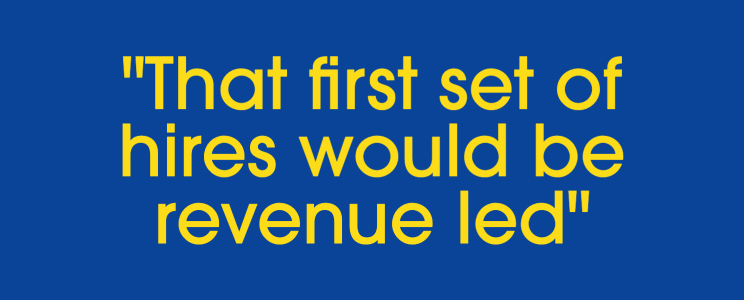How to Build Your Marketing Team in 2023
A case study for a typical VC backed Series A, 100 headcount, B2B SaaS scale-up in 2023. Insightful tips on how to build a marketing team in 2023 to increase revenue, achieve product/market fit and raise brand awareness.
Founders and leaders in the tech scale-up sector will be facing funding constraints in 2023, and working within budgets that are lower than they have been in recent years. So we asked Michael Williamson, a veteran CMO, about how to build a winning marketing function in today’s market.
Michael Williamson is a renowned marketing executive with over 25 years of senior strategic technology marketing experience.
He has held various key positions in the industry, such as Vice President of Marketing for Europe Middle East Africa at Symantec, Chief Marketing Officer Europe at Equifax, Vice President of Marketing for Europe at Staples, Head of Global Marketing at Vodafone Group, and General Manager at Telefonica O2.
Michael has an impressive track record, selling over £27 billion of technology products, services & solutions across Europe, the Middle East and Africa.
ES: Using the case study scenario of a Series A, 100 headcount, SaaS B2B business, how would you shape the marketing function?
MW: Before getting into the hiring plan, we’d need a productivity assessment: is there a strategy currently in place, and is it working? For me, getting the right strategy in place that is going to work and take them forward is step number one.
I’d look at how to streamline functions. For example, we've got AI tools at our fingertips now and the potential for artificial intelligence to remove a significant proportion of jobs by the end of the decade. Companies are using automation to develop lean teams and streamline their operations.
There are two key considerations:
#1: Undertake a productivity assessment
Think about what can be streamlined or automated. What can be improved through the use of tools like AI.
#2: Review of activities
Of those things that can be streamlined or automated, do you actually need to be doing them at all? If the answer is no, remove them from the current activity stack to free up resources.
The process here is to clean the house before starting to hire around it.
ES: What about the founder? Where does their role sit in this marketing productivity assessment?
MW: Founders need to ask themselves what they are doing in the company - are they supporting higher value tasks or lower value tasks? Effectively free up the time of the CEO and executive teams to focus on the strategic direction of the company - those higher value elements. which areas to hire into, which will free up the senior leadership team.
ES: After the productivity assessment and ‘house clean’, what do you see as the priority hires?
MW: That first set of hires would be revenue-led.
The hires brought in need to be focused around revenue delivery, and are typically going to be focused on lead generation and working with the sales team on penetrating the market.
In terms of specific roles and prioritising them, you need to be clear on your client journey. So you have a market and a product or service, now you need to look at connecting that product or service to the market. You generate a lead and then nurture them by driving the differentiation of your offer, to connect them with the sales process.
Then you have performance marketing, which is an ROI-driven role, and also content marketing which is important to drive the lead in the first place and get the market to ‘raise their hand’. Those would be the functions or roles that I’d be hiring first, after getting a leader in place.
ES: Can you define the role of the marketing leader (VP) in the recommended structure?
MW: The role of the marketing leader (VP) is to provide strategic direction. This is one of the key things that scale-ups should think about - they need leaders who are doing the leadership role and not ‘babysitting’ their reports. Having a clear understanding of ‘spans of control’ is important, particularly in terms of technology marketing.
Modern marketing strategy is leaning towards teams of 8 as an ideal size . To drive scale, transparency is needed, and the organisation requires flat structures where communication and agility is easily deployed into the team. A CEO can therefore connect and see what's going on very clearly. There's no place to hide, and equally, people in the marketing team are only one step away from the CEO or leadership team, and that's important in the scale up environment.
ES: Who do you bring in as your full-time headcount versus interim or outsourced agencies?
MW: Definitely, the VP of Marketing should be full-time. And then if there's a team of eight people, they should all be frontline so that there is complete strategic control in terms of how that team is driving performance. And then if there's a team of eight people, they should all be frontline, so that there is complete strategic control in terms of how that team is driving performance.
Roles that I would call ‘client facing’ - that support the client journey and drive interactions with the sales team - those are important roles and should be internal members and they’re likely to be full-time.
However, other roles that are highly focused and bring specialist skills, which are not directly client facing or interacting with sales - such as content marketing, social media or brand marketing - those can be outsourced on a freelance contracting basis and can be part time. You might be purchasing two days a week of somebody's time. You're buying a strong skill set, but because you're buying on a fractional basis, you're paying a much cheaper rate overall.
A freelance content marketing resource to create lead magnets like white papers, engaging video content, interactive calculators
For brand, I would look at this on a project basis, which could be via an agency or a strong freelancer. Get the brand right early on, including the brand architecture and value proposition, then hand it to those key hires in the marketing team to execute the activities.
ES: After the performance marketing and content manager, who would you hire next?
MW: I would hire two digital marketing managers, but with two distinctly different backgrounds. very different remits:
Operational: Customer data and data flow.
Digital infrastructure, website, online funnels routing customers through the client journey.
Digital marketing manager 1:
Within a B2B SaaS model, I’d definitely be thinking about the client journey. I’d want somebody who is strong on customer data, because much of what modern marketing requires today is taking large and complex data sets, and using that information to identify purchase intent for the services you’re selling. It’s a strategic question for CEOs to ask themselves: “Who's running my customer data flow, scraping data sets, getting contact lists of high-intent buyers?”
Is that person able to take that data and use it within digital platforms, whether it be email, advertising platforms or other digital forms of outreach?
You could call it a digital marketing manager, but focus on an operational marketing background. What is strategically important is that this area is becoming the differentiator for a lot of B2B tech firms. Focusing on list quality and how much purchasing intent your list has. That would be my first hire. It’s such a pivotal strategic role, and one that needs to be in-house.
Digital marketing manager 2:
This is somebody who's managing your digital infrastructure. For example, managing the website landing pages, online funnels routing customers through the client journey, replicating in different languages if you are operating in multiple territories - this is the person responsible for managing those assets and conversions.
ES: When would you go to market for a product marketing lead?
MW: If it's all going well, then start looking at a product marketing lead. This person is looking at that client journey and answering questions like, “What's the first thing that we're going to sell to the client?”, “What's the second thing?”, “What's the third thing?”, and defining how to take the customer through the product hierarchy. That person needs to bring the intelligence into the team at that point, and that links into CRM.
Having a specialist is important, because you've got active clients and you need to drive retention in a SaaS model. Secondly, the cross-sell and up-sell is key. Is the company trying to get somebody from monthly SaaS packages onto annual packages; trying to get them to expand the number of users or adding features?
ES: Any marketing trends on your radar to be aware of in the current climate?
Firstly, customer and prospect data. Gone are the days where B2B is the weaker sister to B2C. In fact, most techniques in B2B are now significantly more advanced than B2C, particularly around data.
Secondly, the deployment of artificial intelligence - not only things like automated chat bot messages but also customer interactions.
And lastly, the focus on ROI. Investors want to have companies in their portfolio that are actually driving a return and it’s about the sustainability of that business. Investors are placing a premium on companies that embrace automation and have created a predictable model to deliver shareholder returns and sales on an ongoing basis.
Partner with Santa Monica Talent
We utilise our extensive network within the global tech industry to recruit marketing talent.
Let’s talk!
Call: 07584 022852
Email: ell@santamonica.digital
Ellis Seder is founder and director of Santa Monica Talent. Helping high growth companies, from seed to unicorn. Ellis has 20 years of experience building technology and digital departments for clients, ranging from VC-backed start-ups to global investment banks.
Michael Williamson is available for interim advisory projects - you can DM him on LinkedIn.









